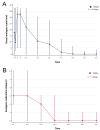Accuracy of Guided Dual Technique in Esthetic Crown Lengthening: A Prospective Case-Series Study
- PMID: 39807032
- PMCID: PMC12087944
- DOI: 10.1111/jerd.13405
Accuracy of Guided Dual Technique in Esthetic Crown Lengthening: A Prospective Case-Series Study
Abstract
Objective: This study aimed to evaluate the efficacy and safety of a digitally guided dual technique during esthetic crown lengthening surgery. In addition, patient satisfaction and patient-reported outcomes were assessed.
Materials and methods: A prospective case series study was conducted. Cone-beam computed tomography and intraoral scans were used to design surgical guides, which were manufactured via 3D printing. The primary outcome was surgical accuracy, assessed by measuring the distance between the planned and final gingival margin positions using overlapping intraoral scans. Secondary outcomes included clinical crown length, gingival margin stability, pain, and patient satisfaction. Statistical analyses were performed using multilevel linear regression models, with significance set at p < 0.05.
Results: Ten participants (87 teeth) were treated without complications. The mean duration of surgery was 66.5 min. The overall absolute deviation was 0.56 mm (95% CI: 0.48 to 0.65) at 6 months postoperatively. Clinical crown length increased significantly from baseline to the end of surgery (p < 0.001), with minimal reduction at 6 months (p = 0.479). Patient-reported outcomes indicated mild postoperative pain and high satisfaction with esthetic results.
Conclusions: The digitally guided dual technique for esthetic crown lengthening surgery is safe and effective, providing highly accurate outcomes. The technique also results in excellent patient satisfaction.
Clinical significance: The use of digitally guided dual techniques for ACL surgery enhances precision and safety, leading to highly accurate outcomes and improved patient satisfaction. This approach could be beneficial in clinical settings to ensure better esthetic and functional results.
Keywords: altered passive eruption; esthetic crown lengthening; guided surgery; patient reported outcomes.
© 2025 The Author(s). Journal of Esthetic and Restorative Dentistry published by Wiley Periodicals LLC.
Conflict of interest statement
The authors declare no conflicts of interest.
Figures







References
-
- Patzer G. L., “Self‐Esteem and Physical Attractiveness,” Journal of Esthetic and Restorative Dentistry 7, no. 6 (1995): 274–276. - PubMed
-
- Armitage G. C., “Development of a Classification System for Periodontal Diseases and Conditions,” Annals of Periodontology 4, no. 1 (1999): 1–6. - PubMed
-
- V. O. Kokich, Jr. , Kiyak H. A., and Shapiro P. A., “Comparing the Perception of Dentists and Lay People to Altered Dental Esthetics,” Journal of Esthetic Dentistry 11, no. 6 (1999): 311–324. - PubMed
-
- Alhumaidan A., Al‐Qarni F., AlSharief M., et al., “Surgical Guides for Esthetic Crown Lengthening Procedures: Periodontal and Prosthetic Aspects,” Journal of the American Dental Association (1939) 153, no. 1 (2022): 31–38. - PubMed
MeSH terms
LinkOut - more resources
Full Text Sources

